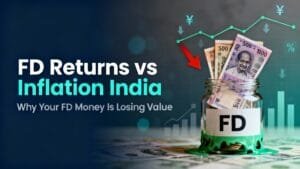Move upMove downToggle panel: Link Suggestions
Money Saving Habit India: 1-Minute Hack Saves ₹10,000/Year
Introduction: Why EPF Retirement Planning is Critical for Every Indian Employee
Are you among the millions of Indian employees who believe their EPF retirement planning will automatically secure their golden years? Here’s a reality check that might surprise you: while EPF forms an excellent foundation, it might not be sufficient for the lifestyle you envision post-retirement.
In today’s inflation-driven economy, EPF retirement planning has become more complex than ever. With healthcare costs skyrocketing and lifestyle expectations rising, the question isn’t just about saving money—it’s about saving smartly. This comprehensive guide will reveal whether your current EPF contributions can truly fund your retirement dreams, and more importantly, what you can do about it right now.
What is EPF and How Does It Impact Your Retirement Planning?
The Employee Provident Fund (EPF) stands as India’s most trusted retirement savings instrument, managed by the Employees’ Provident Fund Organisation (EPFO). When it comes to EPF retirement planning, understanding its mechanics is crucial for every working professional aged 18-45.
Core Components of EPF Retirement Planning
EPF retirement planning involves a systematic approach where both employees and employers contribute towards building a retirement corpus. Here’s how it works:
- Employee Contribution: 12% of basic salary
- Employer Contribution: 12% of basic salary (split between EPF and EPS)
- Government Backing: EPFO ensures security and regulatory compliance
- Tax Benefits: Triple tax exemption under EEE status
Why EPF Forms the Backbone of Indian Retirement Planning
Unlike private retirement schemes, EPF retirement planning offers unmatched security backed by government guarantees. The fund serves multiple purposes beyond retirement, including home purchases, medical emergencies, and educational expenses.
Key Features of EPF: Essential Elements for Effective Retirement Planning
Understanding these features is fundamental to mastering EPF retirement planning:
| Feature | Description | Impact on Retirement Planning |
|---|---|---|
| Employer Contribution | Employers contribute 12% of basic salary matching employee contribution | Doubles your retirement savings automatically |
| Tax Benefits | EEE status – Exempt on contribution, growth, and withdrawal | Maximizes your retirement corpus through tax savings |
| Interest Rate | Government-declared annual rate (8-9% typically) | Provides inflation-beating returns for long-term wealth |
| Portability | Transfer EPF balance when changing jobs | Ensures continuity in retirement planning |
| Withdrawal Flexibility | Partial withdrawals for specific purposes allowed | Provides financial flexibility during emergencies |
| Compounding Benefits | Annual interest compounding on total balance | Accelerates wealth creation through compound growth |
Tax Advantages in EPF Retirement Planning
The tax benefits in EPF retirement planning are substantial:
- Section 80C Deduction: Up to ₹1.5 lakh annual deduction on contributions
- Tax-Free Interest: All interest earned remains tax-free
- Tax-Free Withdrawal: No tax on maturity amount after 5 years of continuous service
Is EPF Enough for Retirement? The Critical Analysis
This is the million-rupee question in EPF retirement planning: Can EPF alone fund your retirement dreams?
The Harsh Reality of EPF-Only Retirement Planning
While EPF provides an excellent foundation, relying solely on EPF retirement planning presents several challenges:
1. Limited Contribution Ceiling
- EPF contributions are capped at 12% of basic salary
- For high earners, this percentage may be insufficient
- Basic salary typically represents 40-50% of total CTC
2. Inflation Impact on EPF Retirement Planning
- Current EPF interest rates: 8.1-8.5% annually
- Historical inflation rates: 4-6% annually
- Real returns after inflation: 2-4% only
- Risk: Your purchasing power may decrease over 20-30 years
3. Lifestyle Inflation Challenges
Modern retirement expectations include:
- Healthcare Costs: Rising at 10-15% annually
- Travel and Leisure: Enhanced lifestyle expectations
- Technology Needs: Digital connectivity and devices
- Dependent Support: Extended family financial responsibilities
EPF Retirement Planning: The Numbers Game
Let’s examine a practical example of EPF retirement planning:
Scenario: 25-year-old employee, ₹50,000 basic salary
- Monthly EPF Contribution: ₹12,000 (₹6,000 each from employee and employer)
- Annual Contribution: ₹1,44,000
- Expected Corpus at 60: Approximately ₹2.5-3 crores (assuming 8% interest and 5% salary growth)
- Monthly Pension Equivalent: ₹25,000-30,000
But is ₹25,000-30,000 monthly sufficient for your retirement lifestyle?
Smart Strategies to Supplement EPF Retirement Planning
Successful EPF retirement planning requires diversification beyond EPF. Here are proven strategies:
1. National Pension System (NPS) Integration
Combining NPS with EPF retirement planning offers:
- Additional Tax Benefits: Section 80CCD deductions
- Market-Linked Returns: Potential for higher returns
- Flexible Investment Options: Equity and debt allocation choices
2. Public Provident Fund (PPF) for Enhanced Security
PPF complements EPF retirement planning through:
- 15-Year Lock-in: Disciplined long-term savings
- Tax-Free Returns: EEE status like EPF
- Loan Facility: Partial withdrawals after 6 years
3. Systematic Investment Plans (SIPs) for Growth
Enhance your EPF retirement planning with SIPs:
- Higher Return Potential: Historical equity returns of 12-15%
- Rupee Cost Averaging: Reduces investment risk
- Flexible Investment Amounts: Start with as low as ₹500
For detailed investment strategies, check out our comprehensive guides:
- Complete ETF Investment Guide: How to Generate 22% Returns with Just 15 Minutes Weekly
- Beat Nifty 50 Returns: Best High Return ETFs in India
- Best ETFs for Long Term Wealth: Complete Investment Guide
4. Real Estate Investment for Rental Income
Real estate can strengthen EPF retirement planning by:
- Rental Income: Regular monthly cash flow
- Capital Appreciation: Long-term wealth creation
- Inflation Hedge: Property values typically rise with inflation
Maximizing Your EPF Retirement Planning: Advanced Strategies
Early Career EPF Optimization (Age 18-30)
For young professionals starting EPF retirement planning:
Action Items:
- Maximize Basic Salary: Higher basic = higher EPF contribution
- Avoid Premature Withdrawals: Let compound interest work
- Track EPF Balance: Use EPFO mobile app regularly
- Understand Nomination: Ensure proper beneficiary details
Mid-Career EPF Enhancement (Age 30-40)
During peak earning years, enhance EPF retirement planning:
Strategic Moves:
- Voluntary Provident Fund (VPF): Additional contributions beyond 12%
- EPF Transfer: Consolidate multiple EPF accounts
- Higher Basic Salary Negotiation: Impact on retirement corpus
- Diversification: Add other retirement instruments
Pre-Retirement EPF Planning (Age 40-45)
As retirement approaches, optimize EPF retirement planning:
Critical Actions:
- EPF Withdrawal Planning: Understand tax implications
- Pension vs Lump Sum: Choose optimal withdrawal strategy
- Estate Planning: Update nominations and beneficiaries
- Healthcare Provision: Plan for medical expenses
EPF Withdrawal Rules and Retirement Planning Impact
Understanding withdrawal rules is crucial for effective EPF retirement planning:
Full EPF Withdrawal Conditions
- Retirement: After age 58 or actual retirement
- Unemployment: After 2 months of continuous unemployment
- Permanent Disability: With medical certification
- Migration: Permanent settlement abroad
Partial EPF Withdrawal for Financial Emergencies
EPF retirement planning allows partial withdrawals for:
- Home Purchase: Up to 90% of EPF balance
- Medical Treatment: For critical illnesses
- Education: Higher education expenses
- Marriage: Wedding expenses (limited conditions)
Tax Implications in EPF Withdrawal
- After 5 Years Service: Tax-free withdrawal
- Before 5 Years: Taxable as income
- Interest Earned: Tax-free if conditions met
Common Mistakes in EPF Retirement Planning
Avoid these critical errors in EPF retirement planning:
1. Ignoring EPF Balance Tracking
- Solution: Regular EPFO portal monitoring
- Impact: Ensures accurate retirement calculations
2. Frequent Premature Withdrawals
- Problem: Reduces retirement corpus significantly
- Solution: Use EPF only for genuine emergencies
3. Not Transferring EPF on Job Change
- Consequence: Multiple dormant accounts
- Resolution: Online EPF transfer process
4. Overlooking Nomination Updates
- Risk: Legal complications for beneficiaries
- Action: Regular nomination review and updates
Technology Tools for EPF Retirement Planning
Leverage technology for effective EPF retirement planning:
EPFO Digital Services
- EPFO Mobile App: Real-time balance checking
- Online Portal: Comprehensive account management
- EPF Transfer: Seamless job change transitions
- EPF Withdrawal: Digital withdrawal processing
Retirement Planning Calculators
Use online calculators to project your EPF retirement planning:
- EPF Calculator: Estimate retirement corpus
- Inflation Calculator: Understand purchasing power impact
- Retirement Needs Calculator: Determine required corpus
Building Wealth Beyond EPF: Investment Platforms
To enhance your EPF retirement planning, consider these trusted platforms:
Free Trading and Demat Account Options:
Free Trading and Demat Account on Dhan
- Zero brokerage on equity delivery
- Advanced trading tools
- Comprehensive research reports
Free Trading and Demat Account on Zerodha
- India’s largest discount broker
- Excellent trading platforms
- Educational resources
Frequently Asked Questions (FAQs) – EPF Retirement Planning
Conclusion: Your EPF Retirement Planning Action Plan
EPF retirement planning forms the cornerstone of financial security for millions of Indian employees, but it’s just the beginning of your retirement journey. While EPF provides unmatched security and attractive returns, the evolving economic landscape demands a more comprehensive approach.
Key Takeaways for Successful EPF Retirement Planning:
- EPF is Essential but Not Sufficient: Use EPF as your foundation, not your complete strategy
- Start Early: The power of compounding makes early investments exponentially more valuable
- Diversify Intelligently: Combine EPF with NPS, PPF, SIPs, and real estate for optimal results
- Monitor Regularly: Track your EPF balance and adjust strategies as needed
- Plan for Inflation: Ensure your retirement corpus maintains purchasing power
Your Next Steps:
- Calculate Your Retirement Needs: Determine your target retirement corpus
- Assess EPF Gap: Identify the shortfall between EPF and required amount
- Create Diversified Portfolio: Implement additional investment strategies
- Review Annually: Adjust your EPF retirement planning strategy based on life changes
Remember, successful EPF retirement planning isn’t about perfect timing—it’s about starting now and staying consistent. Your future self will thank you for the financial discipline you demonstrate today.
Ready to take your retirement planning beyond EPF? Explore our comprehensive investment guides and start building your diversified retirement portfolio today.
The journey to financial freedom begins with a single step. Make EPF retirement planning your stepping stone to a secure and comfortable retirement.







4 thoughts on “EPF Retirement Planning: Complete Guide for Indian Employees 2025”